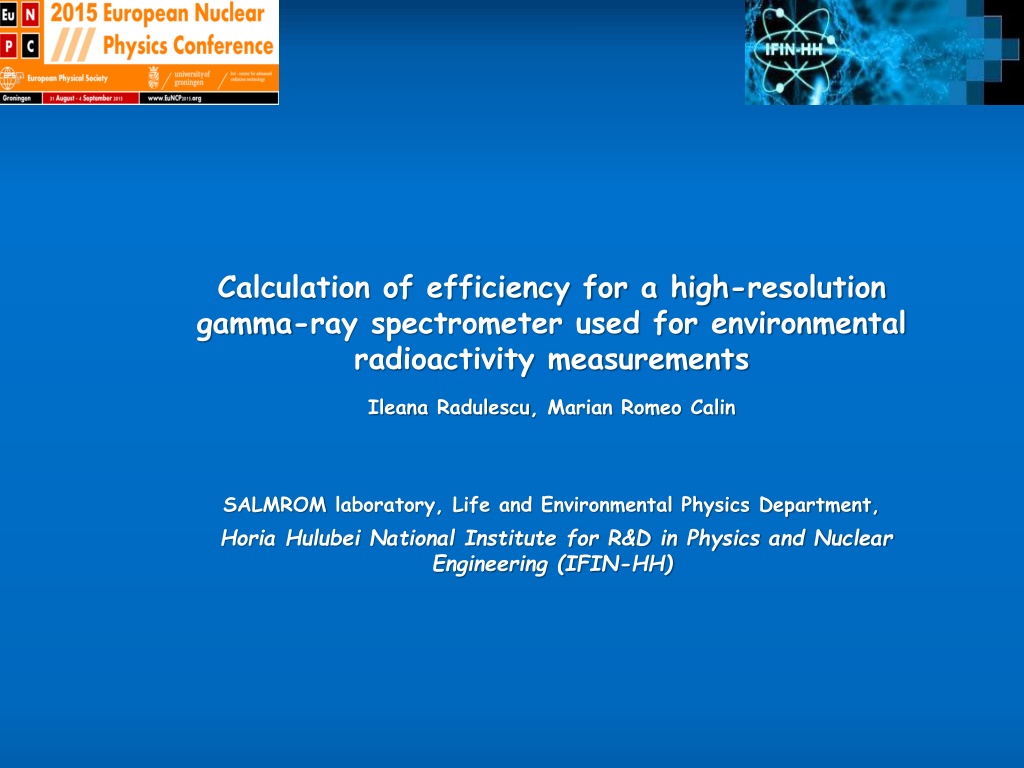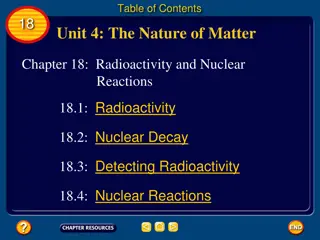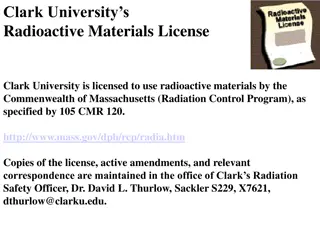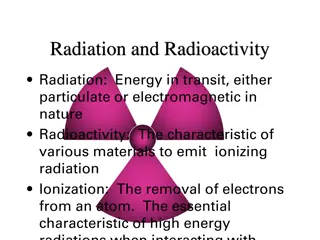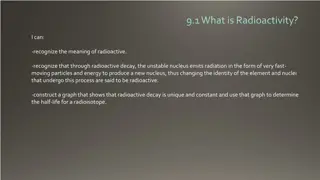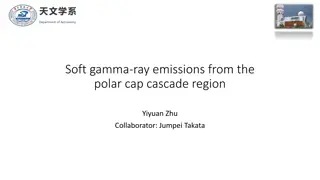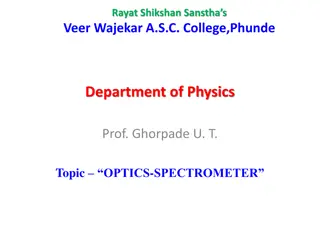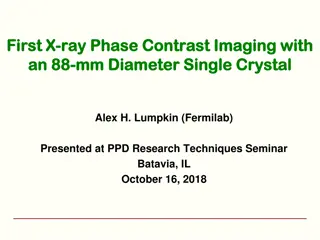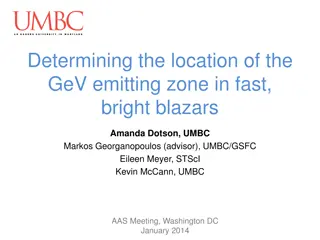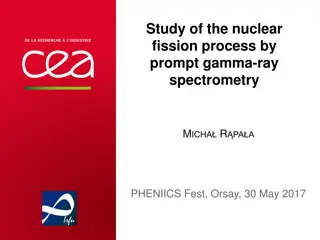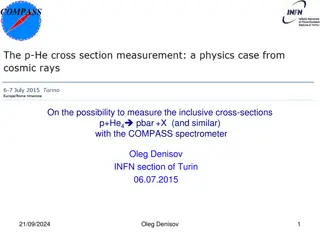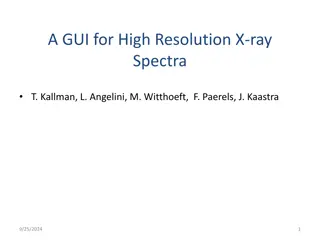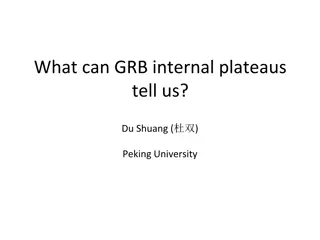Efficiency Calculation of High-Resolution Gamma-Ray Spectrometer for Environmental Radioactivity Measurements
SALMROM laboratory at IFIN-HH conducts environmental radioactivity monitoring using high-resolution gamma-ray spectrometry. The system includes a Coaxial p-type HPGe detector with reliable traceability. Activities involve evaluating radon concentrations in various environments and assessing radionuclide inventories in water, soil, and sediments. Detector characterization and Monte Carlo modeling are used for detector efficiency determination. Samples are analyzed using Marinelli beakers, pill boxes, and vials filled with quality control sample materials for efficiency calibration.
- Gamma-Ray Spectrometer
- Radioactivity Measurements
- HPGe Detector
- Environmental Monitoring
- Efficiency Calculation
Download Presentation

Please find below an Image/Link to download the presentation.
The content on the website is provided AS IS for your information and personal use only. It may not be sold, licensed, or shared on other websites without obtaining consent from the author. Download presentation by click this link. If you encounter any issues during the download, it is possible that the publisher has removed the file from their server.
E N D
Presentation Transcript
Calculation of efficiency for a high-resolution gamma-ray spectrometer used for environmental radioactivity measurements Ileana Radulescu, Marian Romeo Calin SALMROM laboratory, Life and Environmental Physics Department, Horia Hulubei National Institute for R&D in Physics and Nuclear Engineering (IFIN-HH)
Introduction The activity of SALMROM laboratory for , , Spectrometry and Radon Measurements, part of Life and Environmental Physics Department from IFIN- HH, consists in regular monitoring the environmental radioactivity, on daily/monthly bases, in the area of the institute and nearby. Routinely measured isotopes in environmental samples are 60Co, 241Am, 40K, progenies of 238U and 232Th series. Octete Plus alpha Spectrometer Pylon Model AB-5 Portable Radiation Monitor ORTEC HPGe detector MPC 2000 alpha- beta counter
Introduction Other activities, devoted to research programs, are related to evaluation of radon concentration in salt mines, caves, construction sites or former industrial area, to radionuclide inventory in water, soil and sediments in the environment. Type of samples: surface/sea/precipitations/drinking water, cultivated and spontaneous vegetation, aerosols fixed on filters soil, sediments
Reliability and traceabilityof the gamma spectrometry system Coaxial p-type HPGe detector (ORTEC, model GEM 30P4, 35 % relative efficiency, 1.85 keV at 1,332.5 keV, 60Co energy resolution), 59.1 mm diameter, 54.3 mm length (149 cm3 and 0.8 kg) The detector is surrounded by a specially designed shield consisting of 10 cm lead lined with 3 concentric parallelipipedic layers, from copper and aluminium, each of 0.5 mm thickness Traceability of the equipment is assured by using radioactive standards provided by RML IFIN-HH and IAEA.
Detector characterisation Monte Carlo modelling of gamma-ray interactions with the detector Includes modelling of cryostat Parametrised model supplied as input file Validation measurements According to the specifications of the manufacturer: 0.6 mm thick dead layer of the outer contact, 1 mm thick aluminium end cap, 3 mm distance of the end cap to the crystal top surface, 10 mm diameter and 46 mm long central cylindrical hole,
Samples geometry Marinelli beakers pill boxes vials (h=45 mm and d=25 mm, made of glass (density: ~2.50 g cm3) with a wall thickness of 0.5 mm) To determine the efficiency of the detector for these geometries quality control sample material from IAEA was used. Six vials have been filled to different heights (3, 8, 18, 23, 30, 40 mm) with soil from one quality control sample (241Am, 137Cs, 60Co), after it has been dried and homogenized. These calibration samples were then measured for long time. The calibration material was modelled as soil with density 1.6 g cm3. These calibration samples were then measured for long time between 240 000 s and 330 000 s.
Modelling Code: MCNPX The MCNP-X code is a general purpose Monte Carlo radiation transport code developed at the Los Alamos National Laboratory and designed to track different types of particles (neutrons, electrons, gamma rays, etc.) over a broad range of energies. The individual probabilistic events that comprise a process of interaction of nuclear particle with material are simulated sequentially. The process consists of following each of many particles since its emission from a source until it reaches an energy threshold; the particle energy is transferred to the medium by absorption, escape, physical cut-off, etc. The quantities of interest are tallied, along with estimates of the statistical precision of the results. The MCNP-X code can be used, as in the case of this work, to simulate gamma-rays interactions which comprise: i) incoherent and coherent scattering; ii) the possibility of fluorescent emission after photoelectric absorption; iii) pair production with local emission of annihilation radiation and Bremsstrahlung effect.
Experimental results 0.09 241Am 0.08 40 mm 30 mm 23 mm 18 mm 8 mm 3 mm y = -1E-06x3 + 0.0001x2 - 0.0049x + 0.0895 R = 0.9992 0.07 0.06 Efficiency 0.05 Eff measured 0.1 0.04 Efficiency 0.03 Poly. (Eff measured) 0.02 0.01 0 0.01 0.0 10.0 20.0 Distance (mm) 30.0 40.0 50.0 0 200 400 600 Energy (keV) 800 1000 1200 1400 0.03 134Cs (1365 keV) 0.025 y = -3E-09x3 + 7E-06x2 - 0.0008x + 0.028 R = 0.9994 0.02 Efficiency Eff measured 0.015 0.01 Poly. (Eff measured) 0.005 0 0.0 10.0 20.0 Distance (mm) 30.0 40.0 50.0
Simulation results 0.1 eff measured 30 mm eff simulated 30 mm eff measured 40 mm eff simulated 40 mm 0.1 Efficiency Efficiency 0.01 0.01 0 200 400 600 Energy (keV) 800 1000 1200 1400 0 200 400 600 Energy (keV) 800 1000 1200 1400 1.30 1.35 1.28 1.26 1.30 1.24 1.25 1.22 1.20 Ratio 1.20 Ratio 1.18 1.16 1.15 1.14 1.10 1.12 1.10 0 200 400 600 Energy (keV) 800 1000 1200 1400 1.05 0 200 400 600 Energy (keV) 800 1000 1200 1400
Simulation results 0.26 eff measured 8 mm eff simulated 8 mm 0.24 eff measured 3 mm eff simulated 3 mm 0.22 0.20 0.18 0.16 Efficiency 0.1 Efficiency 0.14 0.12 0.10 0.08 0.06 0.04 0.02 0.01 0 200 400 600 Energy (keV) 800 1000 1200 1400 0 200 400 600 Energy (keV) 800 1000 1200 1400 1.45 0.40 1.40 1.35 0.35 1.30 Ratio 0.30 1.25 Ratio 1.20 0.25 1.15 1.10 0.20 1.05 0 200 400 600 Energy (keV) 800 1000 1200 1400 0 200 400 600 Energy (keV) 800 1000 1200 1400
Measurements reliability Proficiency tests Evaluation of the results 228Ac 214Bi 137Cs 40K 212Pb 214Pb 226Ra 208Tl 134Cs 152Eu 241Am IAEA S4 41.0 2.0 50.0 2.8 14.4 0.6 485 11 36.5 1.6 50.0 3.8 50.2 2.0 13.0 0.7 306 20 118.6 1.0 120.9 2.7 Lab S4 38.3 2.9 42.5 2.9 14.6 0.6 465.9 17.0 37.6 1.6 43.6 2.0 39.6 1.7 13.5 1.0 277.6 8.7 114.7 7.0 132.7 5.0 A A A A A A N A A A A
Conclusions - For our MC simulation, the manufacturer s specifications were not sufficient basis for an accurate model, taking into account that for different analyzed geometrical configurations high discrepancies up to 45% with measured data were encountered - deviation between experimental data and simulation 10-45% - for high energy comparable data 10-20% - good reliability on the experimental data - decrease in the efficiency with increasing the height of sample Optimization of the model by increasing dead layer, shapes and distance between crystal and end cap
